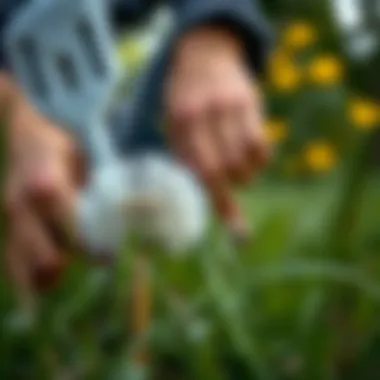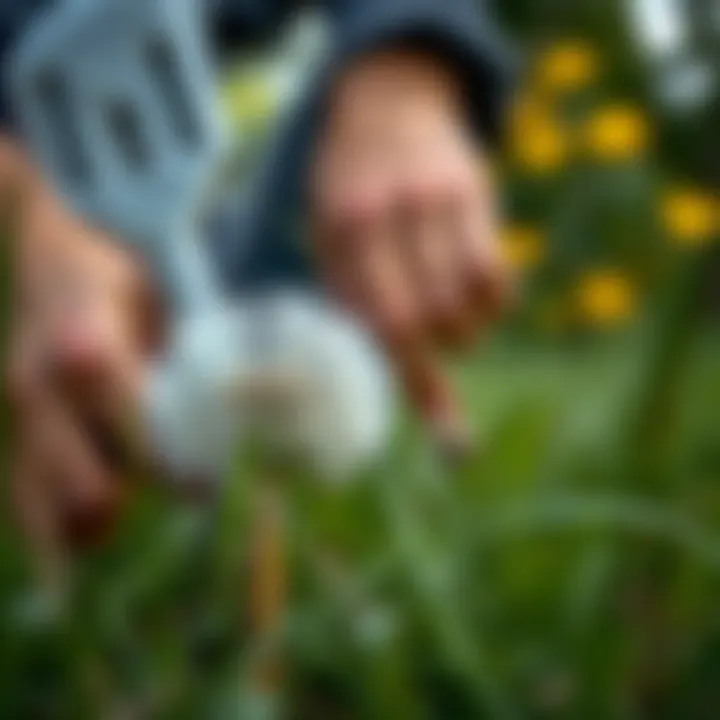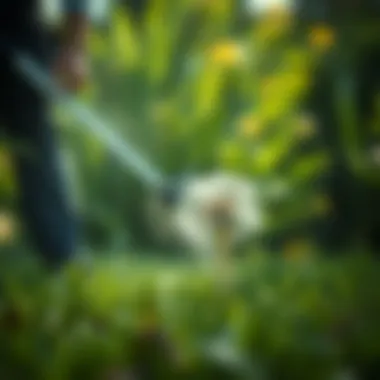Effective Strategies for Dandelion Control in Lawns


Intro
Dandelions, while often seen as a charming symbol of spring with their bright yellow flowers, can become the bane of a homeowner’s existence when they overrun a well-kept lawn. As much as their resilience and ability to thrive in various conditions intrigue gardeners, effectively managing them is crucial for maintaining an appealing landscape. This guide aims to unravel the nuanced methods for dandelion removal, ensuring your lawn remains both aesthetically pleasing and healthy.
Understanding Dandelions
Before diving into removal methods, it’s helpful to understand dandelions themselves. Scientifically known as Taraxacum officinale, these hardy plants boast a taproot that can reach deep into the soil, making them particularly challenging to eradicate. They reproduce via seeds that can travel for miles, ensuring their presence can spread quickly in favorable conditions. This adaptability makes addressing their growth vital for any homeowner seeking lawn perfection.
Relevance of Dandelion Removal
Addressing dandelion infestations isn’t merely about keeping up appearances. Their presence can affect the overall health of your lawn by competing with desirable grass and plants for nutrients and water. Moreover, the lifecycle of these plants can invite more unwanted pests and contribute to soil degradation if left unchecked. Thus, a strategic approach to dandelion management is essential to cultivate a healthy lawn.
As we journey through the methods of removing dandelions, from manual techniques to utilizing chemicals, this article will also highlight sustainable practices and the ecological considerations of each method. Whether you’re a seasoned gardener or a newcomer seeking to enhance your outdoor space, the information provided here aims to equip you with practical, actionable insights.
Understanding Dandelions
Dandelions are often labeled as pesky weeds, but understanding their unique characteristics and the role they play in ecosystems offers a fresh perspective. Gaining insight into these hardy plants aids homeowners and gardening fans in developing effective removal strategies, while also recognizing the implications of their presence within lawns and gardens.
Botanical Characteristics
Dandelions, scientifically known as Taraxacum officinale, possess a distinctive appearance that makes them easy to identify. The vibrant yellow flowers, which can be seen blooming in the spring, eventually transform into fluffy seed heads—often described as a child's favorite "wish blowers." Their deeply serrated green leaves form a rosette at the base of the plant, adding texture to any lawn.
The plant's taproot can penetrate the soil up to several feet deep, making it quite a resilient challenger when it comes to lawn removal efforts. This root is significant because it stores energy, allowing the plant to thrive and re-emerge even after attempts to remove it. Understanding these characteristics is crucial, as it helps homeowners devise suitable strategies to tackle dandelion infestations effectively.
Lifecycle and Growth Patterns
Dandelions follow a unique growth pattern that homeowners should be familiar with. They are perennial plants, meaning they live for multiple years, adapting to their environment remarkably well. The lifecycle begins in early spring, when existing roots produce new leaves and flowers.
The flowers are not just pretty; they attract pollinators like bees, which are essential for a healthy ecosystem. After blooming, the flowers go to seed. A single dandelion can produce several hundred seeds, which can be dispersed by wind to distant areas.
This rapid reproduction means that if dandelions aren't managed early on, they can become a significant nuisance in lawns. Recognizing this pattern allows homeowners to act swiftly when these plants appear, helping to keep infestations in check before they spiral out of control.
Impact on Lawn Ecosystems
While many consider dandelions a menace, it's important to look at the flip side. They play a significant role in lawn ecosystems. For starters, dandelions can contribute to soil health. Their taproots aerate the soil, making it easier for nutrients and water to reach other plants.
Moreover, they provide a food source for several organisms, including insects and birds, promoting biodiversity. Thus, while it may be tempting to eradicate every dandelion in sight, it's essential to weigh the benefits against the desire for a perfect lawn. In some instances, adopting a balanced approach—where dandelions are managed rather than completely removed—can lead to healthier gardens.
In summary, understanding dandelions encompasses appreciating their biology, lifecycle, and ecological roles. This foundation is vital for homeowners, as it empowers them to make informed choices for managing dandelions while maintaining the health of their lawns.
Cultural Controls
In the quest for a dandelion-free lawn, cultural controls offer a proactive approach that lays the groundwork for long-term success. Engaging in practices that promote a healthy lawn not only keeps those pesky yellow flowers at bay but also creates a vibrant ecosystem that benefits both plants and wildlife. By modifying how we care for our lawns, we can naturally suppress dandelion growth without relying solely on chemical solutions.
Optimal Lawn Practices
Proper Mowing Height
Maintaining the right mowing height is critical in the fight against dandelions. Keeping grass taller allows it to shade the soil, limiting sunlight exposure to dandelion seeds. When grass is cut too short, it creates an opportunity for dandelions to thrive due to increased sunlight and available nutrients. Ideally, mowing at a height of three inches or more is advisable. This height not only helps in keeping dandelions down, but also encourages deeper root systems in grass, making lawns more resilient to drought and disease.
However, mowing too high can lead to a messy appearance. Striking a balance is crucial; if you cut the grass too high, it could hinder the growth of desirable grass varieties. Think of it as a Goldilocks approach—not too short, not too high, just the right height to keep both dandelions and lawn healthy.
Soil Health and Aeration
Soil health is often overlooked but is a cornerstone in maintaining a lush lawn. Aerating the soil improves air circulation, reduces compaction, and enhances root growth. Well-aerated soil allows grass to establish a strong root system, which competes effectively against dandelions. Moreover, healthy soil is rich in microorganisms that break down organic matter, releasing nutrients that grass needs while depleting the resources available for dandelions.
Routine spring or fall aeration not only removes thatch but provides space for water and nutrients to penetrate deeper. That said, over-aeration can lead to unnecessary soil disturbance, which might encourage dandelion seed germination instead of limiting it. Thus, it’s wise to aerate strategically, eyeing the lawn’s condition throughout the year.
Watering Techniques
Timing and Frequency
Watering correctly is as pivotal as mowing or aerating in weed management. Dandelions prefer moist conditions, but over-watering can lead to grass weakening and making it susceptible to weeds. Watering in the early morning reduces evaporation and gives grass time to absorb the moisture during the cooler part of the day, but frequent shallow watering won’t suffice. Instead, deep, infrequent watering encourages deeper root systems in grass, which competes better with dandelion roots.
A common mistake is following a rigid schedule instead of adapting to the lawn's specific conditions. For instance, if rainfalls are frequent, the last thing you want is to flood your lawn. Pay attention to the weather and adjust your routine accordingly, ensuring your lawn gets enough but not excessive water.
Targeted Irrigation


Targeted irrigation is about directing water exactly where your grass needs it, reducing excess moisture in non-target areas where dandelions could flourish. Utilizing efficient methods like drip irrigation or soaker hoses helps in achieving this. These systems deliver water straight to the roots, minimizing the chances of water sitting on surface soil that could favor sower germination.
While targeted irrigation methods might involve a bit of initial investment, they ultimately save water and effort in the long run. The key drawback, though, is the setup effort and possibly higher costs than traditional sprinklers. However, for those committed to a dandelion-free lawn, this targeted approach can yield notable improvements.
Fertilization Strategies
Choosing the Right Fertilizer
Selecting the right fertilizer goes a long way in sustaining a healthy lawn that can compete with dandelions. Opt for a slow-release fertilizer tailored to the specific nutrient needs of your grass type. High nitrogen fertilizers can promote grass growth and outcompete dandelions for nutrients.
On the flip side, over-fertilization can lead to lush grass that is, ironically, more inviting to weeds, including dandelions, by creating a nutrient-rich environment. It’s crucial to follow soil testing recommendations to avoid common pitfalls that can backfire.
Timing of Application
Timing is key for fertilization as well; applying fertilizer during active growth periods of grass maximizes absorption and reduces the chance of leaving nutrients available for weeds like dandelions. Early spring when grass begins to grow actively is an excellent time. Yet, if you fertilize too late in the season, the nutrients might not be utilized before the onset of winter.
A downside is that applying at the wrong time can negate the benefits, particularly if a sudden frost is on the horizon. Understanding local climate and your grass’ growth cycle can provide a solid plan for timing application effectively.
Mechanical Removal Methods
Mechanical removal methods play a crucial role in the strategy to deal with dandelions in lawns. Unlike chemical options, these techniques focus on physically eliminating the weed, reducing its spread and establishing a healthier lawn ecosystem. When implemented effectively, they offer immediate results and contribute to sustainable lawn care practices, often aligning well with environmentally-conscious gardening philosophies.
Manual Weeding Techniques
Using Weeding Tools
Using weeding tools such as dandelion pullers and hand trowels offers a hands-on approach to lawn maintenance. The primary characteristic of these tools is their design, enabling users to get deep into the soil and extract dandelions by their roots. This method is especially effective because it targets the entire plant, reducing future growth chances. One appealing aspect of using weeding tools is that it can be done without relying on any chemicals, making it a favorable option for those who prioritize health and environment. Additionally, those tools allow for precision—grabbing a dandelion while avoiding grass roots is an art form in itself. However, it can be labor-intensive and may not be practical for large lawns.
Best Practices for Success
Best practices for successful manual weeding not only involve proper technique but also consideration of timing and soil conditions. The key here is to weed right after a rain or watering session, as moist soil makes it easier to pull the plants out. It’s also smart to target the weeds when they are young, before they can flower and spread seeds. Such an approach enhances the effectiveness of the entire manual removal effort. One unique feature of this method is to maintain regular assessments of the lawn’s condition—knowing when dandelions typically appear helps to tackle the problem before it bloats into a larger issue. The drawbacks may include the time commitment required for consistent upkeep, which can be challenging for busy homeowners.
Lawn Aeration Techniques
Mechanisms of Aeration
Lawn aeration involves perforating the soil with holes to alleviate compaction, allowing air, water, and nutrients to penetrate deeper. This process indirectly aids in managing dandelions by promoting a healthier lawn environment. With increased nutrient absorption, grass strengthens and can outcompete dandelions, which thrive in weak, stressed conditions. Aeration is popular because it addresses multiple lawn issues at once, not just weed removal. The unique feature is that it not only helps in dandelion control but also enhances overall lawn resilience. However, while this method requires some investment in terms of equipment or professional services, its long-term benefits often justify the initial effort and expense.
Post-Aeration Lawn Care
Post-aeration lawn care is vital for maximizing the benefits gained from aerating. After aeration, ensuring the lawn gets enough water, while avoiding soggy conditions, creates optimal growth environment. Apply a light top-dressing of compost to complement the aeration, giving grass and uninvited guests like dandelions a battle for nutrients. Timing the post-care is significant; neglecting the lawn in the weeks following the aeration can squander the effort put in. This method is especially powerful as it works synergistically with the aeration itself. Though it may need a bit of monitoring and strategic planning, the rewards—a flourishing lawn with minimal dandelion presence—are well worth the attention.
Chemical Control Options
When it comes to tackling dandelions in your lawn, chemical control options can be a potent ally. This section provides insight into the types of herbicides available, the nuanced differences between them, and the best practices for application — essential knowledge for homeowners who seek to achieve an aesthetically pleasing and healthy lawn. Understanding these options is crucial not just for effective weed control, but also for maintaining the overall ecosystem of your yard. With the right chemical approaches, you can efficiently manage dandelions alongside the health of your grass.
Overview of Herbicides
Herbicides are categorized based on their mode of action, and selecting the right one can significantly influence the success of your battle against dandelions. They can either inhibit the growth of the weed or kill it outright, leading to a variety of options that range from mild to ultra-effective. The key is to understand their usage, application risks, and the type of dandelions they target.
Factors such as the age of the dandelion and its growth stage can play an important roll in how effective a herbicide might be. Most herbicides work best on young, actively growing plants. Therefore, timing your application can be just as essential as the product you choose.
Selective vs. Non-Selective Herbicides
With selective herbicides, you can target dandelions while leaving your desired grass and plants unharmed. These are particularly useful in a well-maintained yard where the aim is to minimize damage to healthy plants. Non-selective herbicides, on the other hand, kill any plant they touch — making them a risky but sometimes necessary option when facing a significant dandelion invasion. The decision between these two comes down to the extent of the problem and the willingness to risk surrounding vegetation.
- Selective Herbicides:
- Non-Selective Herbicides:
- Target specific weeds.
- Preserve surrounding grass and other plants.
- Requires careful identification of the weed species.
- Effective for total weed eradication, including dandelions.
- Should be used with caution to avoid killing desirable plants.
- Instant results may come at a higher risk.
Application Techniques
Optimal Timing and Conditions
The effectiveness of chemical applications often hinges on meticulous timing and conditions. Applying herbicides at the wrong time can lead to wasted resources and unsatisfactory outcomes. Generally, the best time to treat dandelions is in the spring when the plants are young and actively growing. Also, cool, calm days tend to enhance absorption and minimize drift.
- Key Characteristics of Optimal Timing:


- Usually linked to plant growth stages.
- Ensures maximum efficiency of the chemical.
Choosing this method during warm conditions can increase the likelihood of absorption, as dandelions are usually in their prime growth phase.
Safety Precautions
Using chemicals can pose risks, not just to your lawn but also to your health and the environment. Understanding safety precautions is paramount. This might include wearing protective gear, such as gloves and goggles, and ensuring pets and children remain away during and after application.
- Key Characteristics of Safety Precautions:
- Protects the user from chemical exposure.
- Minimizes environmental impact.
It's sensible to read the label of any herbicide to adhere to prescribed safety measures and to avoid applying on windy days or before rain is forecast. Ignoring these guidelines can lead to unintended consequences, both for you and the ecosystem.
In summary, chemical control methods for dandelion removal offer quick and effective solutions, provided the right products and techniques are employed responsibly. With the right knowledge at your fingertips, homeowners can balance a beautiful lawn while mitigating risks associated with herbicide use.
Natural Alternatives
When it comes to managing dandelions in your lawn, natural alternatives offer a refreshing approach that not only helps with weed control but also promotes a healthier ecosystem. Utilizing methods that avoid synthetic chemicals can enhance soil quality and encourage beneficial organisms. As homeowners and gardening enthusiasts seek to maintain an appealing lawn while minimizing environmental impact, these alternatives become increasingly relevant. With a variety of homemade solutions and companion planting techniques, natural alternatives present effective ways to tackle the stubborn dandelion problem.
Homemade Solutions
Vinegar and Salt
Vinegar and salt are common staples found in most kitchens, making them accessible options for those looking to combat dandelions naturally. This method is effective due to the acetic acid in vinegar, which acts as a desiccant, drawing moisture from the plant. The addition of salt intensifies this process, helping to dehydrate the dandelions effectively.
One key characteristic of this duo is that they are both non-selective in their action; they can harm any plant they touch. While this makes their application crucial, it also highlights a drawback – one must be meticulous to only target the unwanted weeds. To use this method, simply mix a solution of vinegar – preferably the higher concentration varieties – with a few tablespoons of salt. Spray directly onto the dandelions on a sunny day for optimal effectiveness, as warm temperatures enhance the desiccating effect.
Advantages:
- Readily available and inexpensive.
- Effective at killing dandelions quickly.
Disadvantages:
- Potentially harmful to surrounding plants if not applied carefully.
Boiling Water Method
Another simple yet effective method for dandelion removal is the boiling water technique. This method utilizes heat to effectively kill the plant and its root system, thereby preventing regrowth. Pouring boiling water directly onto the dandelions provides an immediate lethal effect, as the heat disrupts the plant's cellular structure.
Moreover, this method is particularly beneficial in terms of eco-friendliness. Unlike chemical treatments, boiling water doesn’t leave behind residues that might harm beneficial insects or soil health. The simplicity of this approach means that homeowners can only wait for a kettle to boil, making it a convenient practice.
Advantages:
- Non-toxic and safe for the environment.
- Direct and swift method of killing weeds.
Disadvantages:
- Requires careful application to avoid harming desired plants.
- Effectiveness may vary depending on the size of the dandelions and surrounding flora.
Beneficial Companion Plants
In addition to homemade solutions, incorporating beneficial companion plants can serve as a proactive strategy in dandelion management. By introducing plants that compete effectively with dandelions for resources, homeowners can reduce the likelihood of dandelion proliferation. For instance, low-growing ground covers such as clover or creeping thyme can effectively outcompete dandelions for sunlight and nutrients, thereby minimizing their growth potential.
Additionally, certain plants can promote soil health and enhance biodiversity, creating a more robust lawn ecosystem. The presence of diverse plant species encourages beneficial insects while also stimulating healthy soil microorganisms. Overall, selecting the right companion plants not only tackles the dandelion issue but also enriches the lawn environment, making it more resilient against future weed invasions.
Sustainable Practices
In recent years, the emphasis on sustainable practices within the realm of lawn care has gained momentum. This section examines the significance of utilizing sustainable methods in tackling dandelion infestations. Sustainable practices not only enhance the health and appearance of your lawn but also contribute positively to the broader ecosystem. Using a holistic approach balances immediate weed removal with long-term ecological health.
One key element of sustainable practices involves minimizing chemical usage. This reduction not only safeguards your lawn but also preserves the environment. Furthermore, embracing these methods encourages a lawn that thrives through natural interactions. This shift in perspective reflects a deeper understanding of how healthy ecosystems function.
Integrative Pest Management
Integrative Pest Management (IPM) promotes a comprehensive, environmentally conscious approach to weed control. Rather than relying solely on herbicides, IPM encompasses cultural, mechanical, and biological strategies. The core philosophy stresses prevention through understanding and managing lawn systems, mitigating the need for aggressive interventions.
IPM emphasizes the role of understanding pest life cycles and environmental factors influencing growth. By focusing on root causes of pest problems, homeowners can implement more effective and sustainable solutions. For instance, identifying conditions that favor dandelion growth—like compacted soil and inadequate mowing—can lead to more targeted approaches that discourage their establishment and proliferation.


Promoting Biodiversity
Biodiversity is a cornerstone of sustainable gardening. Healthy, diverse ecosystems naturally regulate pests and weeds. By implementing practices that nurture various plant life, homeowners can foster resilient lawns. This variety in flora can outcompete dandelions, limiting their space and resources.
Soil Health and Microorganisms
Soil health is fundamentally tied to the presence and activity of microorganisms. Rich, biodiverse soils enable plants to grow vigorously, making it difficult for dandelions to establish themselves. Healthier soil promotes nutrient availability, aeration, and water retention—all essential factors for a thriving lawn.
A key characteristic of healthy soil is its microbial diversity. Microorganisms help break down organic matter, making nutrients available to plants. As these tiny organisms flourish, they create an environment less hospitable to weeds like dandelions by naturally competing for space and resources. The unique feature of fostering skin-friendly microorganisms contrasts starkly with chemical herbicide use, which can disrupt these beneficial organisms and diminish soil health.
Encouraging Beneficial Insects
In addition to soil health, promoting beneficial insects is crucial for sustainable lawn care. Many of these insects, including ladybugs and parasitic wasps, help control pest populations by preying on harmful pests. Likewise, some beneficial insects can contribute to a more balanced ecosystem, reducing the likelihood of dandelion dominance in gardens.
The core characteristic of integrating beneficial insects into lawn care revolves around improving biodiversity. Not only do these insects provide natural pest control, but they also contribute to pollination and the overall vitality of the garden ecosystem.
One unique feature of this approach is how it encourages a lively ecosystem. Unlike reliance on herbicides, which can create hostile environments and kill beneficial species, encouraging beneficial insects fosters resilience in your garden. The flip side? These efforts may take time and patience before achieving noticeable results, but the benefits of such practices far outweigh any short-term inconveniences.
"In nature, everything is interconnected—healthy lawns lead to healthy ecosystems."
By employing these sustainable practices, homeowners not only manage dandelion issues effectively but contribute to creating a thriving environment for various forms of life. With every action taken to nurture biodiversity, you’re reinforcing your lawn’s resilience, paving the way for a beautiful, dandelion-free lawn.
Monitoring and Maintenance
Effective removal of dandelions from your lawn goes hand in hand with diligent monitoring and maintenance. This phase is not merely an afterthought; rather, it is integral to sustaining a healthy, vibrant turf environment. By regularly assessing your lawn, you can identify areas where dandelion growth rears its ugly head, allowing for proactive measures rather than reactive ones. Consistency here is key – without regular checks, a few dandelion plants can rapidly escalate into an unruly patch.
Establishing a routine for lawn assessments can provide several benefits. For starters, it helps you become familiar with the specific conditions of your lawn. Are there areas with particularly poor drainage that promote weed growth? Is there a section that receives too much shade, leading to weakened grass health? Knowing these details not only guides your dandelion management but strengthens the overall integrity of your lawn.
Regular Lawn Assessments
Regular assessments should ideally be monthly during the growing season. Look closely at your lawn's health and how dandelion populations are evolving. Check for:
- Presence of dandelions: Spotting new blooms early is vital.
- Soil condition: Compacted or nutrient-poor soil can be inviting for weeds.
- Grass vigor: Robust grass can naturally choke out weeds, while weakened turf can’t.
While assessing, take notes about specific areas that need attention. This could be as simple as marking areas on a notepad or using a lawn care app to track changes over time. Notations help in identifying persistent problem spots and tailoring your strategies accordingly.
"An ounce of prevention is worth a pound of cure." This saying rings true in lawn care. Regular monitoring allows you to nip potential issues in the bud, catching those troublesome dandelions before they take over.
Adjusting Strategies Over Time
Gardening isn’t a one-size-fits-all affair, especially when it comes to dandelion removal. The strategies you employ today might need tweaking as the seasons change or as your lawn's conditions evolve. Pay attention to what techniques yield the best results. For instance:
- If manual removal works well in one area, but fails in another, consider modifying your approach, like using herbicides selectively.
- Observe the response of your grass; if it looks sad and not vibrant, you might need to consider a change in fertilizer or soil care methods.
Alongside this, seasonal changes play a significant role in strategy adjustment. Fall calls for different practices than spring, as roots prepare for dormancy. Annual reflection on your lawn care routine can determine what’s been efficient and what hasn’t – every year is a chance to learn.
Maintaining an effective lawn culture isn’t a sprint; it’s a marathon. The key is learning from the past and adapting your approach for future success. Small shifts in your care routine can lead to significant improvements over time, turning your lawn into the envy of the neighborhood.
Epilogue
In any discussion about effective dandelion removal from lawns, the conclusion serves as a crucial synthesis point, drawing together the multiple threads of information presented earlier in the article. Understanding effective strategies, whether they be through cultural practices, mechanical means, chemical options, or natural alternatives, sets the stage for a comprehensive approach to lawn care. Each of these methods has its own unique benefits and must be tailored to the specific needs of one's lawn and personal preferences as a gardener.
With the ongoing trend towards sustainable and eco-friendly gardening practices, homeowners must prioritize methods that support the health of their lawns while safeguarding the surrounding ecosystem. Dandelions, while often viewed as nuisances, play an ecological role that merits understanding. Thus concluding with a broader perspective on the interconnectedness of lawn management, one recognizes that the choices made today affect not just the appearance of a lawn, but the overall health of the environment.
Summarizing Key Points
Throughout this article, the fundamental strategies for dandelion removal have been explored in detail. Here are the key takeaways:
- Understanding Dandelions: Their biological characteristics and ecological impacts emphasize the need for informed management.
- Cultural Controls: Incorporating optimal lawn practices, watering techniques, and fertilization strategies fosters healthier environments that can resist dandelion invasions.
- Mechanical Removal Methods: Manual weeding and lawn aeration are effective, hands-on strategies for maintaining control over these persistent plants.
- Chemical Control Options: Awareness of herbicides, along with proper application techniques, is essential for selective yet effective management.
- Natural Alternatives: Utilizing homemade solutions and companion planting offers eco-friendly options that can coexist with other lawn ecosystems.
- Sustainable Practices: Encouraging biodiversity and integrating pest management contribute to a balanced approach that respects nature.
- Monitoring and Maintenance: Regular assessments and adaptable strategies help ensure long-term success in lawn care.
Future Considerations
Trends in Lawn Management
As lawn management continues to evolve, there is an increasing focus on sustainable practices that not only remove unwanted plants like dandelions but also enhance the overall ecological framework of lawns. One notable trend is the transition from traditional grass lawns to more diverse plant landscapes that require less maintenance and naturally suppress weeds. This shift acknowledges the role of dandelions and other native plants in supporting local wildlife, such as bees and other pollinators.
The key characteristic of this trend includes a shift towards lower water usage and reduced reliance on chemical inputs, making it a popular choice for environmentally-conscious homeowners. As more individuals seek to transition towards these practices, the unique feature of cultivating a varied flora offers advantages like enhanced soil health and reduced maintenance needs.
Continuous Learning and Adaptation
In the realm of lawn management, continuous learning and adaptation remain paramount. Homeowners are increasingly encouraged to modify their gardening techniques based on changing environmental conditions and emerging practices. Adapting strategies means utilizing resources such as local gardening clubs, online forums, and expert consultations to stay updated with new developments in weed management.
The unique aspect of this approach is recognizing that lawn care is not a one-time endeavor but a lifelong journey of learning. This characteristic not only empowers homeowners to experiment with innovative approaches but also contributes to a resilient ecosystem. The advantages lie in improved adaptability to unexpected challenges such as climate change while still achieving the goal of maintaining a healthy lawn.
A well-managed lawn is not just a visual asset; it embodies a commitment to sustainable practices that enhance biodiversity and ecological health.



